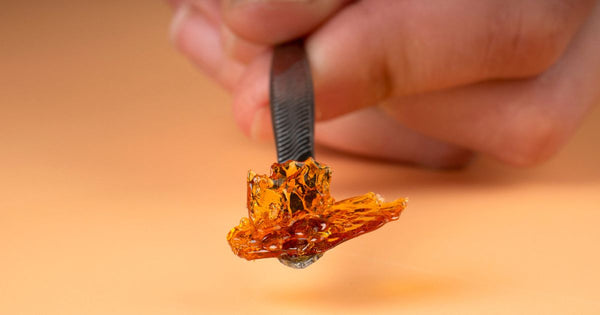Color Remediation Explained: CRC in Live Resin Production
Apr 17, 2023

Over the past few years, live resin has captured the hearts and taste buds of connoisseurs across the globe. This golden, aromatic treasure is renowned for its unmatched flavor and potency, offering users a rich, full-spectrum experience unlike any other.
However, as the market becomes increasingly competitive, producers are constantly seeking ways to elevate their products.
Visual appeal has become a deciding factor among many consumers. Enter color remediation, a cutting-edge filtration technique that has revolutionized live resin production by transforming once-dark extracts into radiant, crystal-clear concentrates.
The Science Behind Live Resin Production
Live resin is a true testament to the art and science of cannabis extraction. Born from a passion for preserving the full spectrum of flavors, aromas, and effects that the plant has to offer, this exquisite cannabis concentrate is a labor of love that goes beyond traditional extracts. It is in this intricate creation process that live resin earns its distinction as a connoisseur's delight.
Unlike other cannabis concentrates, live resin begins with freshly harvested plants that are immediately flash-frozen. This critical step helps retain the plant's rich terpene profile, which is partially lost during the drying and curing process.
Terpenes, the aromatic compounds that give cannabis its signature scent, are not only responsible for the delightful fragrances but also play a crucial role in modulating the effects of cannabinoids, creating a synergistic experience for the user.
The extraction process itself is a delicate dance between art and science, utilizing advanced techniques such as a CO2, ethanol, or butane hash oil (BHO) extraction process to carefully separate the coveted cannabinoids and terpenes from the plant material.
Skilled technicians meticulously monitor temperature, pressure, and other factors to ensure the resulting live resin is a true reflection of the plant's essence, capturing its complex flavors, aromas, and effects in a concentrated form.
As the live resin makes its way from the extraction lab to the consumer, its appearance becomes a vital aspect of its allure. A shimmering, golden hue has become synonymous with quality, inviting users to indulge in a one-of-a-kind sensory journey.
This is where color remediation steps in, adding a touch of refinement to any cannabis extract by removing undesirable pigments and impurities, while preserving the cherished characteristics that make this concentrate truly exceptional.
What Is Color Remediation?

At its core, color remediation is a purification process that leverages the power of adsorption to selectively remove unwanted color pigments and other impurities from cannabis extracts.
By using carefully chosen filter media, such as activated silica gel, activated bentonite clay, diatomaceous earth, or activated charcoal, color remediation transforms dark, opaque extracts into radiant, translucent concentrates.
But the magic of color remediation is not merely skin deep. As it polishes the appearance of live resin, it simultaneously enhances the products’ flavor profile, allowing the delicate symphony of terpenes to come through more clearly and harmoniously.
The resulting live resin is not only visually captivating but also a gustatory delight that tantalizes the senses and elevates the cannabis experience to new heights. However, like any powerful tool, color remediation demands skill and precision.
Mastering the art of color remediation requires a deep understanding of the process, from selecting the appropriate filter media and ratios to fine-tuning pressure, flow rate, and temperature. It is in the hands of these skilled artisans that color remediation finds Its true potential, transforming dull and hazy concentrates into veritable works of art.
Color Remediation Column (CRC) Workflow Explained
Color remediation is a powerful technique that transforms cannabis extracts into visually appealing, high-quality concentrates. The process involves passing the extract through a color remediation column (CRC) packed with various filter media that selectively remove impurities and color pigments from the extract.
Extraction technicians use layers of filter media, each with its unique preparation process. Some filter media may need to be heated and dried before use, while other media is ready-to-use out of the bag. Extraction technicians use a specific ratio of media and cannabis extract, and depend on the type of media, biomass quality, and extraction system.
Extraction technicians then add the media to the CRC. The crude extract is then run through the column. As the extract passes through the column, certain compounds are adsorbed by the filter media, resulting in a clearer and more pure product. The filtered extract is collected at the bottom of the column and is now free from pigments and other impurities.
Advantages and Disadvantages of Color Remediation
Color remediation has undeniably revolutionized the live resin production process, offering a new level of refinement and sophistication. However, like any innovative technique, it has its fair share of advantages and disadvantages.
Advantages
- Enhanced visual appeal: The most immediately noticeable benefit of color remediation is the transformation of dark, cloudy extracts into radiant, golden CRC extracts. This visual upgrade not only increases the perceived quality of the product but also adds an enticing allure for consumers seeking an exquisite cannabis experience.
- Improved taste and aroma: By removing undesirable compounds, color remediation allows the cannabinoids and terpenes to shine more brightly. Although live resin is already known for an unreal aroma and taste, the resulting live resin boasts a cleaner, more pronounced flavor profile that tantalizes the taste buds and enchants the senses.
- Better marketability: In an increasingly competitive industry, color remediation-treated live resin stands out on the shelves, attracting discerning consumers who value quality, purity, and aesthetics. This enhanced marketability ultimately leads to higher sales and a stronger brand reputation.
Disadvantages
- Increase production costs: The color remediation process requires additional equipment, filter media, and skilled technicians, which translates to higher production costs. These costs may be passed on to the consumer, potentially pricing out some customers.
- Potential loss of valuable compounds: While color mediation is designed to selectively remove unwanted elements, there's always a risk of losing some desirable compounds in the process. Striking the perfect balance between purification and preservation requires skill and experience which not all producers possess.
- Requires skilled technicians: Mastering the color remediation process demands deep knowledge of its intricacies. The need for highly skilled technicians may pose a barrier for smaller producers looking to adopt this technique.
Filter Media Sample Request
Interested in trying our filter media? We would love to send you some! Browse our products, then fill out this form and someone from our team will be in touch to finalize your request.
Addressing Criticisms and Concerns About CRC
As with any groundbreaking technique, color remediation has faced its share of criticisms.
- Purity vs. potency and flavor debate: One of the most significant debates about CRC is whether the pursuit of purity and visual appeal comes at the cost of potency and flavor. Critics argue that by focusing too heavily on aesthetic refinement, producers may inadvertently remove some of the very compounds that contribute to live resins' unique effects. With refined techniques, however, purification does not have to sacrifice taste or potency.
- Preserving the full spectrum experience: Live resin is celebrated for offering a complete, full spectrum experience that captures the true essence of the cannabis plant. Some argue that CRC may diminish the experience by altering the natural balance of cannabinoids and terpenes. In response, producers must be transparent about their color remediation methods, emphasizing the commitment to preserving the full spectrum experience.
- Consumer education and transparency: A significant concern with CRC is a potential for misleading marketing practices that focus solely on the visual appeal of the final product. Producers and retailers must educate consumers about the CRC process and the impact it has on live resin quality. By creating a culture of transparency and open communication, the industry can help consumers make informed choices and appreciate the true value of color remediation.
CRC – Elevating Live Resin Production
Color remediation has emerged as a game-changing technique in the live resin production industry. Producers can now selectively remove impurities while preserving the compounds that make live resin so great.
Although CRC is a complex and precise process, the resulting concentrates are well worth the effort. CRC-treated live resin products stand out on dispensary shelves, attracting consumers who value quality, purity, and aesthetics.







